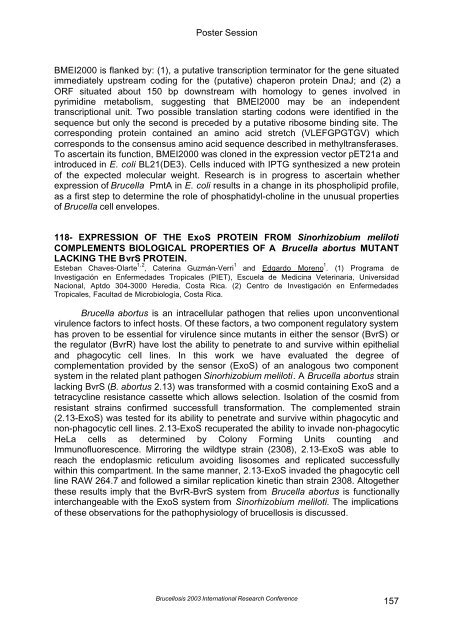Brucellosis 2003 proceedings - PHIDIAS
Brucellosis 2003 proceedings - PHIDIAS
Brucellosis 2003 proceedings - PHIDIAS
You also want an ePaper? Increase the reach of your titles
YUMPU automatically turns print PDFs into web optimized ePapers that Google loves.
Poster Session<br />
BMEI2000 is flanked by: (1), a putative transcription terminator for the gene situated<br />
immediately upstream coding for the (putative) chaperon protein DnaJ; and (2) a<br />
ORF situated about 150 bp downstream with homology to genes involved in<br />
pyrimidine metabolism, suggesting that BMEI2000 may be an independent<br />
transcriptional unit. Two possible translation starting codons were identified in the<br />
sequence but only the second is preceded by a putative ribosome binding site. The<br />
corresponding protein contained an amino acid stretch (VLEFGPGTGV) which<br />
corresponds to the consensus amino acid sequence described in methyltransferases.<br />
To ascertain its function, BMEI2000 was cloned in the expression vector pET21a and<br />
introduced in E. coli BL21(DE3). Cells induced with IPTG synthesized a new protein<br />
of the expected molecular weight. Research is in progress to ascertain whether<br />
expression of Brucella PmtA in E. coli results in a change in its phospholipid profile,<br />
as a first step to determine the role of phosphatidyl-choline in the unusual properties<br />
of Brucella cell envelopes.<br />
118- EXPRESSION OF THE ExoS PROTEIN FROM Sinorhizobium meliloti<br />
COMPLEMENTS BIOLOGICAL PROPERTIES OF A Brucella abortus MUTANT<br />
LACKING THE BvrS PROTEIN.<br />
Esteban Chaves-Olarte 1,2 , Caterina Guzmán-Verri 1 and Edgardo Moreno 1 . (1) Programa de<br />
Investigación en Enfermedades Tropicales (PIET), Escuela de Medicina Veterinaria, Universidad<br />
Nacional, Aptdo 304-3000 Heredia, Costa Rica. (2) Centro de Investigación en Enfermedades<br />
Tropicales, Facultad de Microbiología, Costa Rica.<br />
Brucella abortus is an intracellular pathogen that relies upon unconventional<br />
virulence factors to infect hosts. Of these factors, a two component regulatory system<br />
has proven to be essential for virulence since mutants in either the sensor (BvrS) or<br />
the regulator (BvrR) have lost the ability to penetrate to and survive within epithelial<br />
and phagocytic cell lines. In this work we have evaluated the degree of<br />
complementation provided by the sensor (ExoS) of an analogous two component<br />
system in the related plant pathogen Sinorhizobium meliloti. A Brucella abortus strain<br />
lacking BvrS (B. abortus 2.13) was transformed with a cosmid containing ExoS and a<br />
tetracycline resistance cassette which allows selection. Isolation of the cosmid from<br />
resistant strains confirmed successfull transformation. The complemented strain<br />
(2.13-ExoS) was tested for its ability to penetrate and survive within phagocytic and<br />
non-phagocytic cell lines. 2.13-ExoS recuperated the ability to invade non-phagocytic<br />
HeLa cells as determined by Colony Forming Units counting and<br />
Immunofluorescence. Mirroring the wildtype strain (2308), 2.13-ExoS was able to<br />
reach the endoplasmic reticulum avoiding lisosomes and replicated successfully<br />
within this compartment. In the same manner, 2.13-ExoS invaded the phagocytic cell<br />
line RAW 264.7 and followed a similar replication kinetic than strain 2308. Altogether<br />
these results imply that the BvrR-BvrS system from Brucella abortus is functionally<br />
interchangeable with the ExoS system from Sinorhizobium meliloti. The implications<br />
of these observations for the pathophysiology of brucellosis is discussed.<br />
<strong>Brucellosis</strong> <strong>2003</strong> International Research Conference<br />
157
















